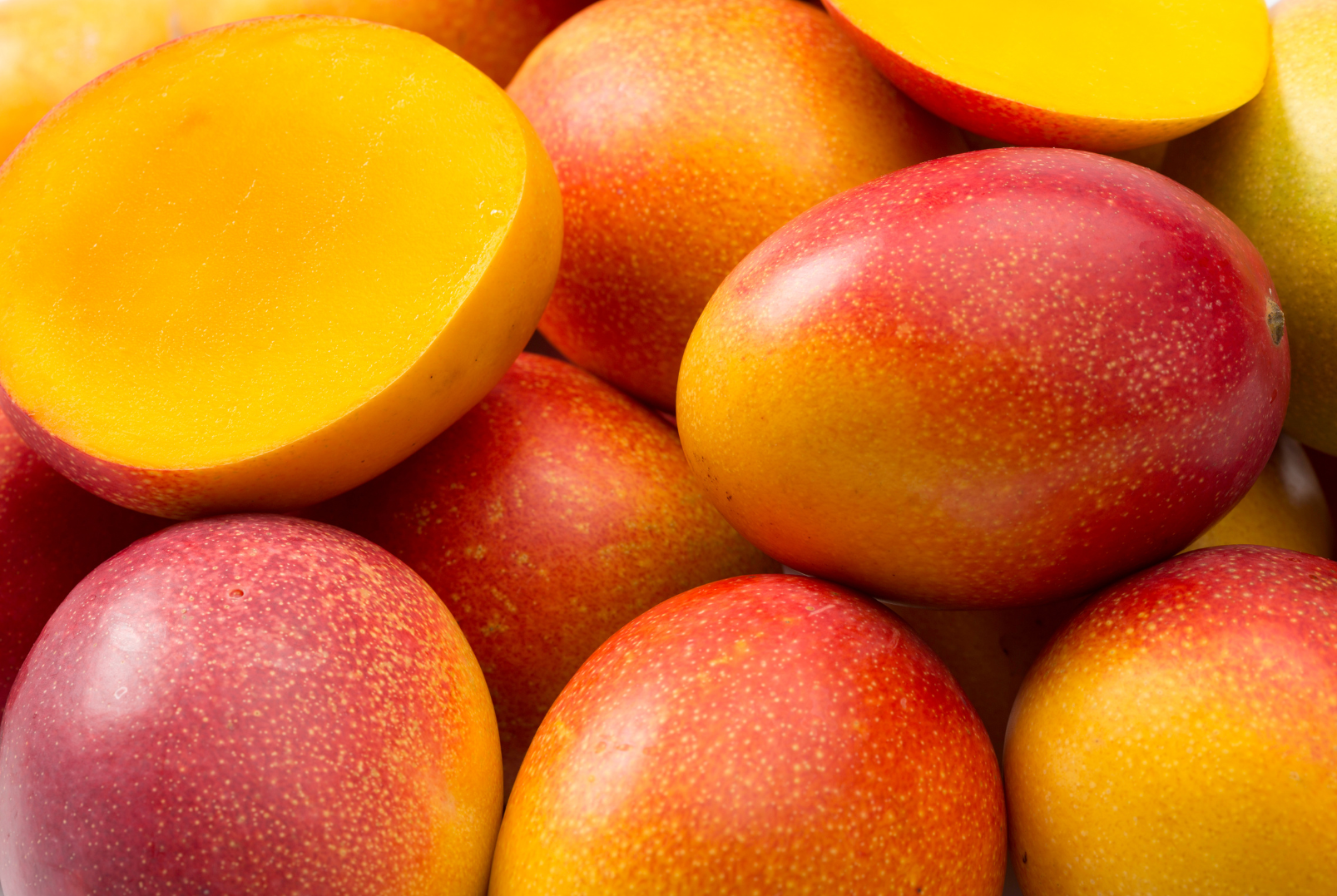القيمة الغذائية والفوائد الصحية للمانجو

ايضا تتوفر هذه المقالة باللغات الاتية:
ايضا تتوفر هذه المقالة باللغات الاتية:
![]() English (الإنجليزية)
English (الإنجليزية) ![]() Español (الأسبانية)
Español (الأسبانية) ![]() Français (الفرنسية)
Français (الفرنسية) ![]() Deutsch (الألمانية)
Deutsch (الألمانية) ![]() हिन्दी (الهندية)
हिन्दी (الهندية) ![]() Ελληνικά (اليونانية)
Ελληνικά (اليونانية)
يعتبر الكثيرون المانجو “ملك” الفواكه نظرًا لاستهلاكها طازجة واستخدامها في إعداد الحلويات وعصائر الفاكهة والمربات. بالإضافة إلى ذلك، إنها مصدر غني أيضًا للفيتامينات A وB و C والسكر والكربوهيدرات والبروتين والدهون والألياف والماء والعديد من المزيد.
بشكل أكثر تحديدًا، واستنادًا إلى إدارة الأغذية والعلاج في الولايات المتحدة، تحتوي حبة واحدة من المانجو (٣٣٦ جرام) على:
الطاقة: ٢٠٢ سعرة حرارية – ٨٤٠ كيلوجول
- الماء: ٢٨١ جرام
- البروتين: ٢.٧٦ جرام
- الألياف الغذائية الكلية: ٥.٣٨ جرام
- السكريات الكلية بما في ذلك القيم اليومية الموصي بها: ٤٦ جرام
- البوتاسيوم: ٥٦٤ ملليغرام
- الكالسيوم: ٣٧ ملليغرام
- الفوسفور: ٤٧ ملليغرام
- المغنيسيوم: ٣٣.٦ ملليغرام
- الحديد: ٠.٥٣٨ ملليغرام
- الكاروتينات: ٦١ ملليغرام
تحتوي المانجو على بعض الكميات الصغيرة من السيلينيوم والنحاس والزنك والمنجنيز. بالنسبة للفيتامينات، تحتوي على ١٢٢ ملليغرام من فيتامين C (أكثر من ٥٠٪ من الجرعة اليومية الموصى بها)، و١٨١ ميكروغرام من فيتامين A و٣.٠٢ ملليغرام من فيتامين E.
بالإضافة إلى كونها فاكهة لذيذة، هناك العديد من الفوائد الصحية المرتبطة بتناول المانجو لصحة الإنسان. يمكن أن تساهم في:
- تقليل مخاطر الإصابة بسرطان القولون، وسرطان الثدي، وسرطان اللوكيميا، وسرطان البروستاتا، وذلك بفضل وجود مضادات الأكسدة (بيتا كاروتين) ومستويات عالية من فيتامينات C وA في المانجو.
- تقليل مستويات الكولسترول بفضل مستويات عالية من الألياف وفيتامين C التي يوفرها تناول الفاكهة.
- تحسين صحة العين والبشرة، بالإضافة إلى تحسين عملية الهضم.
- المساهمة في الوقاية من فقر الدم.
- تعزيز صحة القلب (الجهاز القلبي و الاوعية الدموية) وخفض ضغط الدم.
على الرغم من الفوائد الصحية العديدة، يجب استهلاك المانجو بشكل عاقل، مثل أي طعام آخر. على الرغم من وجود حالات نادرة جدًا تستجيب للحساسية، إلا أنه من الأفضل تقشير الفاكهة وعدم استهلاك القشرة التي تحتوي على كميات صغيرة من اليوروشيول.
مراجع
https://fdc.nal.usda.gov/fdc-app.html#/food-details/169910/nutrients
Find more information in the book: “Success in Agribusiness: Growing Mango successfully” written by James Mwangi Ndiritu
Codex Alimentarius Commission. General Principles of Food Hygiene CXC 1-1969. 2021.
De Graaf J. Developing a Systems Approach for Sternochetus mangiferae (Coleoptera: Curculionidae) in South Africa. J Econ Entomol. 2010; 103(5):1577–85.
Dias, C.S.; Rodrigues, R.G.; Ferreira, J.J. What’s new in the research on agricultural entrepreneurship? J. Rural. Stud. 2019, 65, 99–115.
FAO. The Future of Food Safety; FAO: Rome, Italy, 2019.
Grové T, De Beer MS, Daneel MS, Steyn WP. Scale and mealybug survey on mango in Mpumalanga and Limpopo Provinces South Africa. Acta Hortic. 2013; 1007:377–84.
Grové T, De Villiers EA, Daneel MS. Mango. In: Prinsloo GL, Uys VM, editors. Insects of cultivated plants and natural pastures in Southern Africa. Pretoria: Entomological Society of Southern Africa; 2015a. p. 574–88.
Grové T, De Villiers EA, Schoeman PS. Litchi. In: Prinsloo GL, Uys VM, editors. Insects of cultivated plants and natural pastures in Southern Africa. Pretoria: Entomological Society of Southern Africa; 2015b. p. 554–9.
Grové T, De Beer MS, Joubert PH. Monitoring fruit flies in mango orchards in South Africa and determining the time of fruit infestation. Acta Hortic. 2009; 820:589–96. .
Grové T, De Beer MS. Insect pests affecting the production of mango in South Africa. Acta Hortic. 2017b; 1183:297–304.
Grové T, De Beer MS. Species composition and abundance of fruit flies (Diptera: Tephritidae) in subtropical fruit orchards in the Mbombela Local Municipality South Africa. Fruits. 2019; 74(1):18–24
Haran J, Grové T, Van Noort S, Benoit L, Addison P. Natural biocontrol of fruit flies in indigenous hosts: A perspective for population control in the agroecosystem. Biol Control. 2019; 137:1–6.
Henri, D. C., Jones, O., Tsiattalos, A., Thebault, E., Seymour, C. L., van Veen, F. J. F. F., et al. (2015). Natural vegetation benefits synergistic control of the three main insect and pathogen pests of a fruit crop in southern Africa. J. Appl. Ecol. 52, 1092–1101.
Hill MP, Macfadyen S, Nash MA. Broad spectrum pesticide application alters natural enemy communities and may facilitate secondary pest outbreaks. PeerJ. 2017; 19(5):e4179.
Joubert PH, Daneel MS, Grové T. Progress towards Integrated Pest Management (IPM) on mangoes in South Africa. Acta Hortic. 2000;509:811–8.
Joubert E, Grové T, Booysen G. Evaluation of fruit fly (Diptera: Tephritidae) monitoring systems on mango in Limpopo Province South Africa. J Agric Sci Technol. 2015;B5:653–63.
Louw CE. The mango seed weevil, Sternochetus mangiferae (Fabricius) (Coleoptera: Curculionidae); understanding the pest in order to ensure effective control measures. Acta Hortic. 2013;992:441–57.
Louw E. Evaluation on the efficacy of different chemicals on gall fly larvae in mangoes. Subtrop Fruit J. 2021;30:18–20.
Kibira, M., Affognon, H., Njehia, B., Muriithi, B., Mohamed, S., and Ekesi, S. (2015). Economic evaluation of integrated management of fruit fly in mango production in Embu County, Kenya. Afric. J. Agric. Resour. Econ. 10, 343–353
King, T.; Cole, M.; Farber, J.M.; Eisenbrand, G.; Zabaras, D.; Fox, E.M.; Hill, J.P. Food safety for food security: Relationship between global megatrends and developments in food safety. Trends Food Sci. Technol. 2017, 68, 160–175.









































































